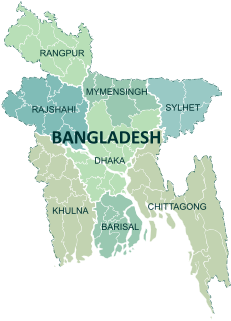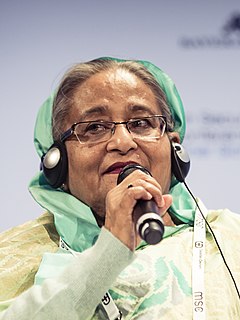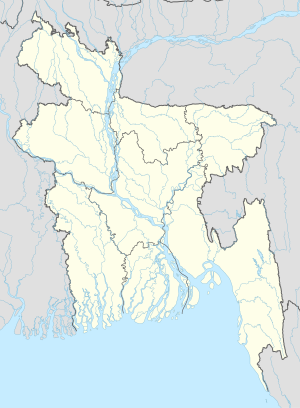
Bangladesh, officially the People's Republic of Bangladesh, is a country in South Asia. It is the eighth-most populous country in the world, with a population exceeding 162 million people. In terms of landmass, Bangladesh ranks 92nd, spanning 148,460 square kilometres (57,320 sq mi), making it one of the most densely populated countries in the world. Bangladesh shares land borders with India to the west, north, and east, Myanmar to the southeast, and the Bay of Bengal to the south. It is narrowly separated from Nepal and Bhutan by the Siliguri Corridor, and from China by Sikkim, in the north, respectively. Dhaka, the capital and largest city, is the nation's economic, political, and cultural hub. Chittagong, the largest seaport, is the second-largest city.

Bengal is a geopolitical, cultural and historical region in South Asia, specifically in the eastern part of the Indian subcontinent at the apex of the Bay of Bengal. Geographically, it is made up by the Ganges-Brahmaputra delta system, the largest such formation in the world; along with mountains in its north bordering the Himalayan states of Nepal and Bhutan and east bordering Burma.

Dhaka, formerly known as Dacca, is the capital and the largest city of Bangladesh. It is the ninth-largest and the sixth-most densely populated city in the world, with a population of 8.9 million residents within the city limits, and a population of over 21 million residents in the Greater Dhaka Area. Dhaka is the economic, political and cultural center of Bangladesh. It is one of the major cities of South Asia, the largest city in Eastern South Asia and among the Bay of Bengal countries; and one of the largest cities among OIC countries. As part of the Bengal plain, the city is bounded by the Buriganga River, Turag River, Dhaleshwari River and Shitalakshya River. The city is located in an eponymous district and division.

The economy of Bangladesh is a developing market economy. It's the 35th largest in the world in nominal terms, and 30th largest by purchasing power parity; it is classified among the Next Eleven emerging market middle income economies and a frontier market. In the first quarter of 2019, Bangladesh's was the world's seventh fastest growing economy with a rate of 7.3% real GDP annual growth. Dhaka and Chittagong are the principal financial centers of the country, being home to the Dhaka Stock Exchange and the Chittagong Stock Exchange. The financial sector of Bangladesh is the second largest in the Indian subcontinent. Bangladesh is one of the world's fastest growing economies.

Bibhag is the first-level administrative division in Bangladesh. There are 8 divisions of Bangladesh. Each division is named after the major city within its jurisdiction that also serves as the administrative headquarters of that division. Each division is further split into several districts which are then further sub-divided into Upazilas.

Sheikh Mujibur Rahman, shortened as Sheikh Mujib or just Mujib, was a Bangladeshi politician and statesman. He is called the "Father of the Nation" in Bangladesh. He served as the first President of Bangladesh and later as the Prime Minister of Bangladesh from 17 April 1971 until his assassination on 15 August 1975. He is considered to be the driving force behind the independence of Bangladesh. He is popularly dubbed with the title of "Bangabandhu" by the people of Bangladesh. He became a leading figure in and eventually the leader of the Awami League, founded in 1949 as an East Pakistan–based political party in Pakistan. Mujib is credited as an important figure in efforts to gain political autonomy for East Pakistan and later as the central figure behind the Bangladesh Liberation Movement and the Bangladesh Liberation War in 1971. Thus, he is regarded "Jatir Janak" or "Jatir Pita" of Bangladesh. His daughter Sheikh Hasina is the current leader of the Awami League and also the Prime Minister of Bangladesh.

The Bangladesh Air Force, is the aerial warfare branch of the Bangladesh Armed Forces, primarily tasked with the air defence of Bangladesh's sovereign territory, and providing air support to the Bangladesh Army and Bangladesh Navy. Additionally, the service has a territorial role of providing tactical and strategic air transport and logistics capability for the country.

Chittagong, officially Chattogram and known as the Port City of Bangladesh, is a major coastal city and financial centre in southeastern Bangladesh. The city has a population of more than 8.4 million in 2016, making it the second-largest city in the country. It is the capital of an eponymous District and Division. The city is located on the banks of the Karnaphuli River between the Chittagong Hill Tracts and the Bay of Bengal. Modern Chittagong is Bangladesh's second most significant urban center after Dhaka.

Sheikh Hasina, also known by her married name Sheikh Hasina Wazed, is a Bangladeshi politician serving as the 10th Prime Minister of Bangladesh, having held the office since January 2009. Having previously served as Prime Minister for five years, she is the longest-serving Prime Minister in the history of Bangladesh.

The Bangladesh Liberation War, also known as the Bangladesh War of Independence, or simply the Liberation War in Bangladesh, was a revolution and armed conflict sparked by the rise of the Bengali nationalist and self-determination movement in what was then East Pakistan during the 1971 Bangladesh genocide. It resulted in the independence of the People's Republic of Bangladesh. The war began after the Pakistani military junta based in West Pakistan launched Operation Searchlight against the people of East Pakistan on the night of 25 March 1971. It pursued the systematic elimination of nationalist Bengali civilians, students, intelligentsia, religious minorities and armed personnel. The junta annulled the results of the 1970 elections and arrested Prime minister-designate Sheikh Mujibur Rahman. The war ended on 16 December 1971 after West Pakistan surrendered.

The Bangladesh men's national cricket team, popularly known as The Tigers, is administered by the Bangladesh Cricket Board (BCB). It is a Full Member of the International Cricket Council (ICC) with Test, One-Day International (ODI) and T20 International (T20I) status. It played its first Test match in November 2000 against India in Dhaka, becoming the tenth Test-playing nation.

The Bangladesh Navy is the naval warfare branch of the Bangladesh Armed Forces, responsible for Bangladesh's 118,813 square kilometres (45,874 sq mi) of maritime territorial area, and the defence of important harbours, military bases and economic zones. The primary role of the Bangladesh Navy is to protect the country's economic and military interests at home and abroad. The Bangladesh navy is also a front line disaster management force in Bangladesh, and participates in humanitarian missions abroad. It is a key regional player in counter terrorism efforts, and engages in global peacekeeping with the United Nations.

The Bangladesh Army is the land warfare branch, and the largest of the three armed services of Bangladesh Armed Forces. The primary mission of the Army is to provide necessary forces and capabilities to deliver the Bangladeshi government's security and defence strategies, and most notably, defending the nation's territorial integrity against external attack. Control of personnel and operations is administered by the Department of the Army, Armed Forces Division. In addition to its primary mission the Bangladesh Army is also constitutionally obligated to assist the government and its civilian agencies during times of domestic national emergency. This additional role is commonly referred to as "aid to civil administration".

Bengalis or Bangalees/Bangalis, also rendered as the Bengali people, are an Indo-Aryan ethnolinguistic group native to the Bengal region in South Asia. The population is divided between the region of Bangladesh and the Indian states of West Bengal, Tripura and Assam's Barak Valley. Most of them speak Bengali, a language from the Indo-Aryan language family. The term "Bangalee" is also used to denote people of Bangladesh as a nation.

Bengali, also known by its endonym Bangla, is an Indo-Aryan language and the lingua franca of the Bengal region of the Indian subcontinent, spoken by the Bengalis in Bangladesh and India. It is the most widely spoken language of Bangladesh and second most widely spoken of the 22 scheduled languages of India, after Hindi. With approximately 228 million native speakers and another 37 million as second language speakers, Bengali is the fifth most-spoken native language and the seventh most spoken language by total number of speakers in the world.

Bangladeshis are the citizens of Bangladesh, a South Asian country centered on the transnational historical region of Bengal along the eponymous bay.

Climate change in Bangladesh is a pressing issue. According to National Geographic, Bangladesh is one the most vulnerable nations to the impacts of climate change. Bangladesh being located on the Tropic of Cancer receives fairly direct radiation throughout the year and maintains relatively high temperature.

The divisions of Bangladesh are divided into 64 districts or zila. The capital of a district is called a district seat. The districts are further subdivided into 493 sub-districts or upazila.

The COVID-19 pandemic in Bangladesh is part of the worldwide pandemic of coronavirus disease 2019 caused by severe acute respiratory syndrome coronavirus 2. The virus was confirmed to have spread to Bangladesh in March 2020. The first three known cases were reported on 8 March 2020 by the country's epidemiology institute, IEDCR. Since then, the pandemic has spread day by day over the whole nation and the number of affected people has been increasing.
















